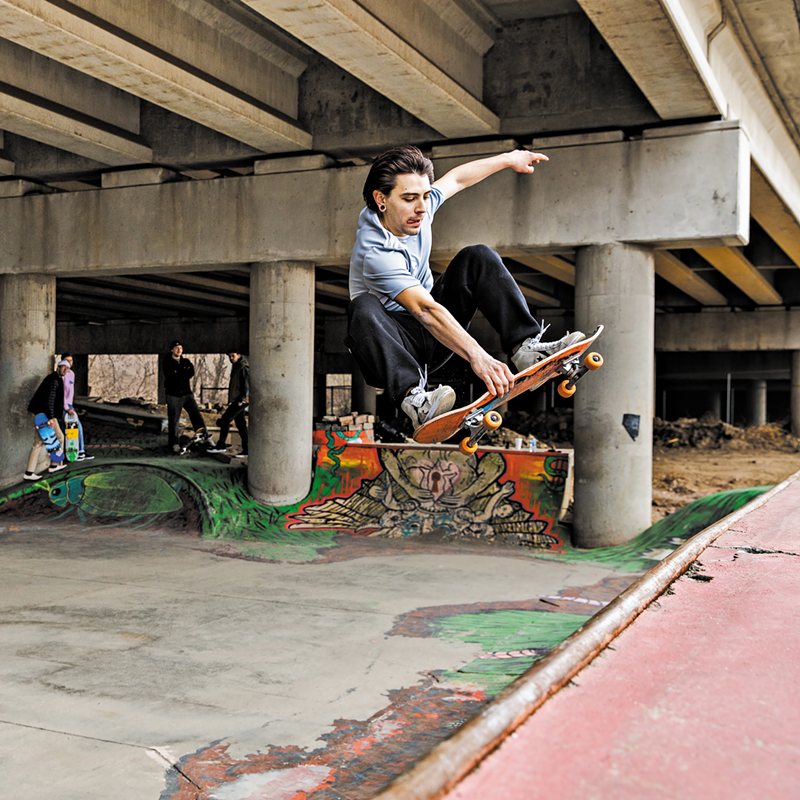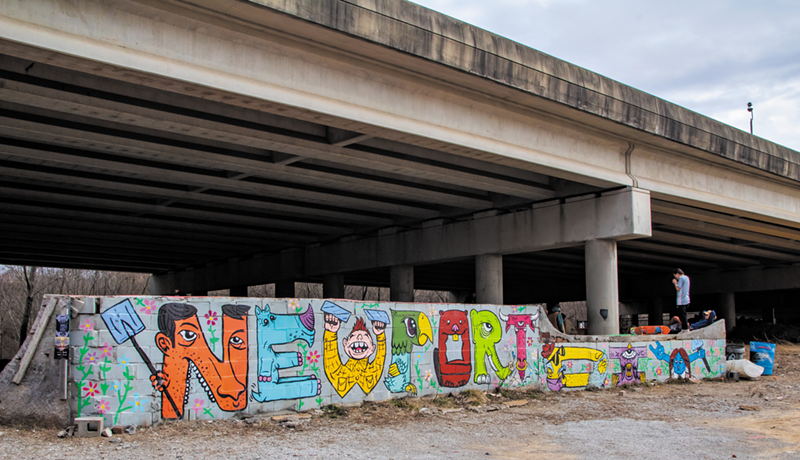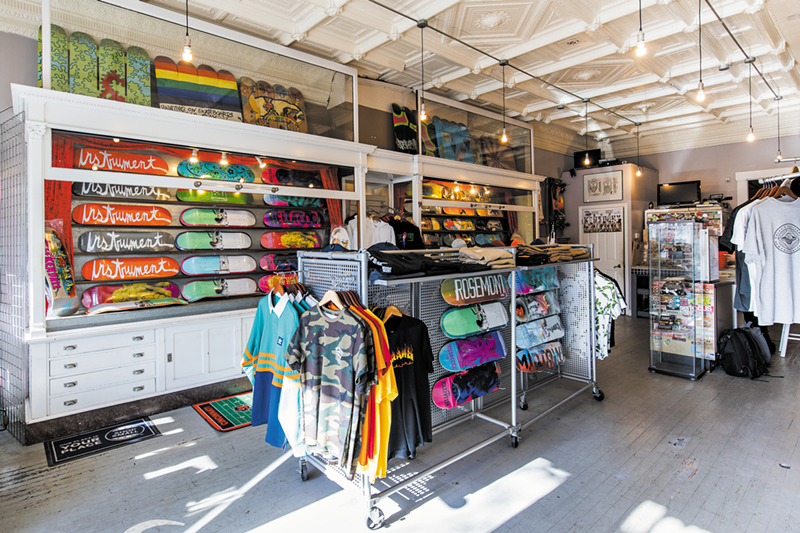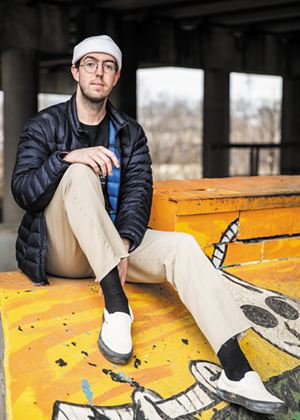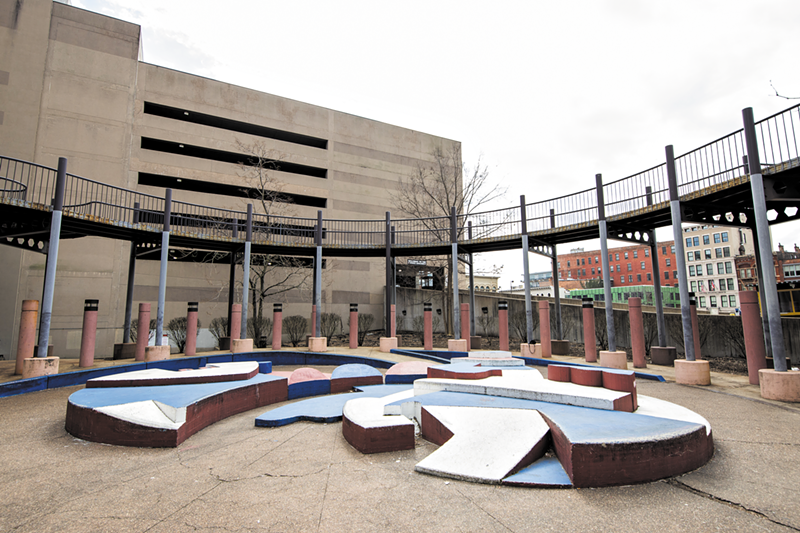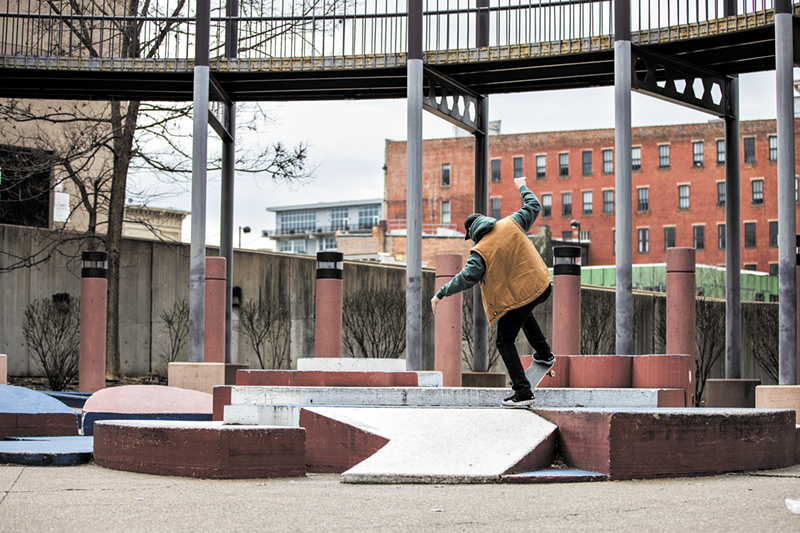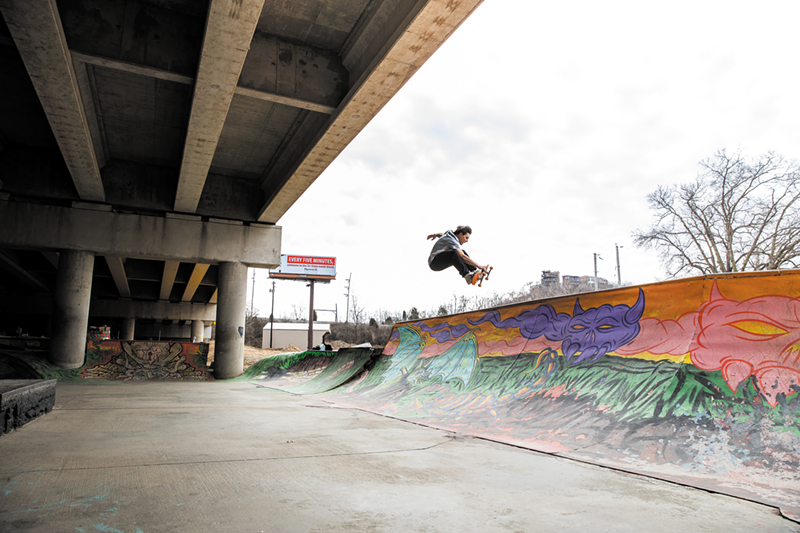If your perception of skateboarding has been shaped by Hollywood or ESPN, you might associate the pastime with massive wooden half pipes, deliberately designed concrete theme parks and conspicuous energy drink sponsorships. According to the X Games or An Extremely Goofy Movie, skating is an activity that takes place in a controlled environment primed to push physics to its limits — pop culture’s conception of a skatepark is as accessible to the masses as the International Space Station.
Take a peek into the subculture, though, and you’ll discover that skating is almost synonymous with accessibility. On the city streets, it can take the form of the nearest handrail, loading dock or flight of stairs — a single heelflip or smith grind can turn these common urban structures into artwork.
Architectural historian Iain Borden describes this phenomenon as a “space in which body, skateboard and terrain were brought together and recomposed in an extraordinary encounter.” In layman’s terms, this means that skaters can extract beauty from their urban landscape just by interacting with it: street skaters might not achieve the big air or pirouettes you’d see on ESPN, but they do achieve a greater philosophical end.

“Every city has unlimited skate spots,” says Gary Collins, owner of Newport, Kentucky’s Galaxie Skateshop. “If they have concrete and it’s a big city, they have skate spots everywhere.”
If you’ve spent any time walking downtown or driving aimlessly, it’s likely you recognize many of them — you just may not have realized it.
“Skate photographers really love it here,” says Joe Castrucci, who owns the Cincinnati-based Habitat skateboard company. “People will come into town and be like, ‘Wow, this place is so photogenic.’ I think the hills surprise people, too — I think people don’t expect to see them in the Midwest.”
The spots even have a unifying effect among folks living on either side of the Ohio river, according to Collins.
“People over here are like, ‘We’re not going to Cincinnati.’ People over there are like, ‘We’re not going over to Kentucky.’ Skaters never had that barrier. If there’s some cool shit on either side of the river, we’re skating it,” he says.
Below, local skaters and skate OGs have helped create a roadmap of the city’s most iconic skate spots: a collection of vacant lots and hangouts bound not by geography or purpose, but by their conduciveness to skateboarding and the lore they’ve inspired.
Newport DIY Skatepark
It’s a slow Monday afternoon at Galaxie Skateshop — Gary Collins and I have the storefront to ourselves until the mayor of Newport drops in.
“Hey, Jerry, what’s the story with the window sill out in the yard?” asks Collins.
“The sandstone? There’s about five of them,” says Jerry Peluso, his back to a display full of skateboard decks.
“Can I buy one of them off of you?”
If Collins and Peluso appear to be a pair of unlikely pals, that’s because they are. Two of the driving forces behind Newport’s DIY skatepark — hand-crafted beneath the I-471 bridge — the duo’s work is a testament to collaboration.
“The idea (for the park) was conceived by the previous owner of Galaxie, my friend Andrew Martin,” says Collins. “He just started building under the bridge, like, renegade, with a box, and then a quarter pipe. When I bought the shop, I reached out to the city a little bit more about letting us push it. That gave me more resources and more pull to bring in a bigger crew to do big work.”
It was thanks to Martin that the spot was officially recognized by the city. In 2008, he approached Peluso about clearing the area of mud and debris in exchange for creative control beneath the overpass.
Peluso, who also happens to be Galaxie’s landlord, was enthusiastic about the idea — the city had long considered building a park, and the DIY spot’s remote location would provide a space for skaters to ride without being chased off by cops.
When Collins bought Galaxie in 2009, he made it his mission to further expand the park with Peluso’s approval.
“Usually city governments can be the worst when it comes to skating, but here it’s different,” Collins says. “Without Jerry, the DIY would never be what it is today — that’s because we created a personal relationship with city government and didn’t fucking blow it. For all these years, we’ve done things for the city. Even the cops asked us to set up ramps and come skate at their National Night Out event. They need us to scratch their back, and we do it.”
He particularly remembers corralling a group of skaters to help Peluso decorate the city for Thanksgiving — one of Galaxie’s earliest efforts to establish connections with Newport’s municipal government.
What was originally a few parking blocks and wooden ramps has now become an urban oasis. A former pro skater and founder of the Instrument skate brand, Collins used his vast network to raise funds for the project. Thanks to a $1,000 grant from Citigroup, $14,000 donated by local nonprofit Newport Foundations and contributions from regular customers, the park now boasts an empty pool and an impressive array of ramps — all designed and built by skaters. Even the concrete was hand-mixed.
“You can’t even measure the impact it’s had on the skateboarding scene out here,” Collins says. “It’s created a cohesive place for everyone who skates in Cincinnati and Northern Kentucky. Anywhere in the Midwest.”
One of just a few fully-fledged DIY parks in the country, the spot under the bridge brings in a steady stream of pros and road-trippers.
“Now, every time a pro crew comes through, they want to go to the bridge,” Collins says. “You’ll be down there, and you never know who you’ll see. The most mind-blowing person I’ve seen come through there is (former Thrasher Skater of the Year) Grant Taylor. But the local guys who skate there, they’re fucking ridiculous, too.”
That said, Collins’ favorite spot to take visitors from out of town isn’t even a spot at all — it’s Cincinnati’s surplus bounty of hills.
“When visiting pros used to come through, they’d want to go to the popular spots they’d seen in videos,” he says. “We’d be like, ‘Cool, but we’re gonna go bomb these hills for a little bit and then we’ll go.’ They’d be shook.”
Collins’ DIY doesn’t just end with the park under the bridge. Galaxie will relocate to the site of a former corner store in West Newport on May 1, and with the move comes more space to build. Starting with a wooden ramp plucked from the DIY, the store will begin housing a new spot in its own backyard.
“A new larger space will allow us to continue our legacy of pushing things forward for the greater Cincinnati skateboarding scene,” reads a recent post on the Galaxie Facebook page. “Rest assured the new space will be next level.”
D.O.
Plastic thermos of coffee in hand, local skater and Northern Kentucky University student Chris Fenton-Wells scrolls through a VICE article in the passenger seat of my old Honda CR-V. Though the February rain has kept most folks indoors, it hasn’t stopped our spot check as we drive through Clifton.
This first stop on the tour is the D.O. banks: a parking lot sandwiched between the offices of Gaslight Property and a Bruegger’s Bagels. “People have always told me this, but I’d never really looked it up before,” he says. “Garry Scott Davis invented the boneless here in 1980.”
Ask any local and they’ll tell you the same. Davis, better known as GSD, was a seminal figure in skate culture’s formative years. In addition to inventing one of the earliest street tricks, the Cincinnati native also founded the world’s first skate ’zine (Skate Fate), fronted a band that toured with Drive Like Jehu (Custom Floor) and became the first pro skater to sell a deck designed for street skating (Tracker’s Banks/Curbs model).
D.O. — nicknamed while an adjacent building was still a doctor’s office — might just be comprised of a couple banks and ledges in a paved lot, but it’s a historical landmark to members of Cincinnati’s skate scene.
Nick Accurso, web designer and owner of Cincinnati sneaker boutique UNheardof, says he remembers catching bus rides to the banks from the West Side in the early ’80s.
“We’d ride downtown, then up to Clifton,” he says. “We’d hang out there and catch the last bus downtown at 10, then skate there until midnight before taking the last bus back home. You really can’t do that these days.”
“Back in the day you could go there on the weekends and it would be a massive mess of different crews there,” Galaxie’s Collins says. “Cops would come in, and everybody would dip in all directions. That’s pretty much my first memory of it.”
Shapes
“This place had to be made to skate,” says Fenton-Wells. “What other reason could there be for it to look like this? Besides looking cool, that is.”
It’s hard to disagree with him. Across from the Duke Energy Convention Center, we stop by the “Shapes,” a cubist heap of concrete ramps and curbs that adds a surreal touch to its landscape. Its patriotic paint job has been weathered by elements and years of skating, lending to its Chernobyl-like appearance. It’s so unbelievably skateable that it wouldn’t feel out of place in a Tony Hawk’s Pro Skater video game cityscape.
Shapes’ flatter portions act as large manual pads, and its abundance of ledges provides plenty of opportunities to grind and boardslide. There’s even a formidable flight of steps leading to the adjacent building’s employee entrance, which has served as the site of many locals’ first time skating stairs. A small, rusted nub filled with ice — the ghost of a former handrail — juts from the bottom step.
The Steve Miller Band’s “Space Cowboy,” soundtracking Fountain Square’s ice rink, thumps faintly in the background, lending the space an even eerier aura.
Collins' memories of the spot extend further than skating. When he was growing up, the spot was billed as a playground and an outdoor workout device. Many paint jobs ago, Shapes was surrounded by signs that demonstrated exercises that could be performed on the concrete structures.
Though he remembers frequently being kicked out of the spot for skating in the late ’80s, Shapes has gradually become much more skate-friendly — perhaps due to confusion over what it actually is.
“Sometimes even the cops don’t know what it is! They think it’s a skatepark,” Collins says. “It’s a weird-ass place that just happens to be cool for skating.”
P&G and Bam Rail
Black scuff marks from a pointillist stormcloud against a decaying concrete wall. Backdropped by a chain link fence, the structure could be mistaken for a piece of industrial modern art if it weren’t for the metal sign nailed to it.
“No Trespassing: Bicycle Riding, Skateboarding, & Loitering are…” reads the sign. The word “prohibited” is concealed by a sticker advertising Lawrenceburg, Indiana’s Blacklist skateshop.
Efforts to scare skaters away from the parking lot behind the P&G Towers seem to have been fruitless — the evidence of countless wallrides is left in plain view.
It’s the spot that former pro Duane Pitre, who rode for G&S and Alien Workshop in the ’90s, most clearly associates with the city — you can see him and the G&S team skating the banks and setting off fireworks there in a 1990 video starring Neil Blender.
“There used to be an electrical box there with a bump up to it,” says Habitat's Castrucci. “That was pretty iconic.”
According to Fenton-Wells, the lot is a last stop of the night for many locals. “It takes so much energy to push your way to the bank that you get exhausted after a while,” he says.
Just a mile east is another Cincinnati skate video staple — a wide concrete slope hidden behind the Gateway West Office Park on Linn Street.
“That bank’s the main part, but it’s called the bam rail because of the flight of steps over there,” says Fenton-Wells. “The handrail’s made of aluminum, so when your trucks hit it, you’ll either grind or immediately wreck.”
Despite the name, the slope is the bigger draw — skaters who clear the rail at its peak can use the bank as a medium for manuals.
“It’s definitely been on Thrasher a lot,” he says. “Random videos where people come through Cincinnati, and pretty much every local video.”
It’s Cincinnati’s rugged charm that lends itself to street skating so well, suggests UNheardof's Accurso.
“When I was skating, the West Coast started to get boring,” he says. “They had all the schoolyards and incredible, perfected skaters. In the mid-’90s, you started to have all these East Coast skaters making street skating cool. Raw stuff, cruising through the streets. Here, we had all those rawer spots.”
Though a less-pristine finish can make spots harder to skate, the challenge only supplements street skating’s ethos — breathing new life into the obscure or overlooked portions of the cityscape.
It’s difficult to describe this relationship between skater and city without dipping into a vocabulary of Zen-like aphorisms like “becoming one with one’s environment.” Perhaps there’s a greater, spiritual element to skateboarding that transcends tricks.
Borden, the aforementioned architect, seems to think so. In his book Skateboarding, Space and the City, he suggests that the pastime is an early stage of humankind’s evolution into Homo Urbanus — a species wholly suited to city life.
“The skateboarder’s highly developed integrated sense of balance, speed, hearing, sight, touch and responsivity is then a product of the modern metropolis,” he writes. “The aim is not only to receive the city but to return it to itself, to change through movement and physical energy the nature of the experience of the urban realm.”
Watch a skater take a stroll downtown or drive around in search of parking and you’ll believe it: the way they scan their environment in search of rails or banks is akin to a sixth sense.
That flight of stairs you take en route to the office; your favorite parking spot; the park bench in front of the corner store — add a skater to the equation, and all of these can become art.

